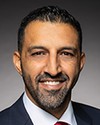Thank you.
Yes, there are challenges in all aspects of this, certainly with respect to generation. The reality is that it is more challenging today than it was 10 years ago to build infrastructure. The challenges of siting, the challenges of seeking approvals, the complexity of this work has simply increased. That's just the reality that we need to deal with, and it's something that everybody in the sector is addressing.
We are going to require, yes, two to three times more clean electricity. It will be a combination of large-scale grid generation and small-scale distributed-energy resources and community-level resources. Much of the infrastructure, though, will also need to be built out as well from a transmission standpoint. The challenge with respect to transmission is that we do not have an effective subnational coordination function for the planning and construction of transmission at a regional basis. These are done at a provincial basis only.
We recently had some research that we commissioned that looked at other jurisdictions that have been more successful at building transmission infrastructure and some lessons learned that we might be able to apply in Canada, and we'll provide that to the committee.





